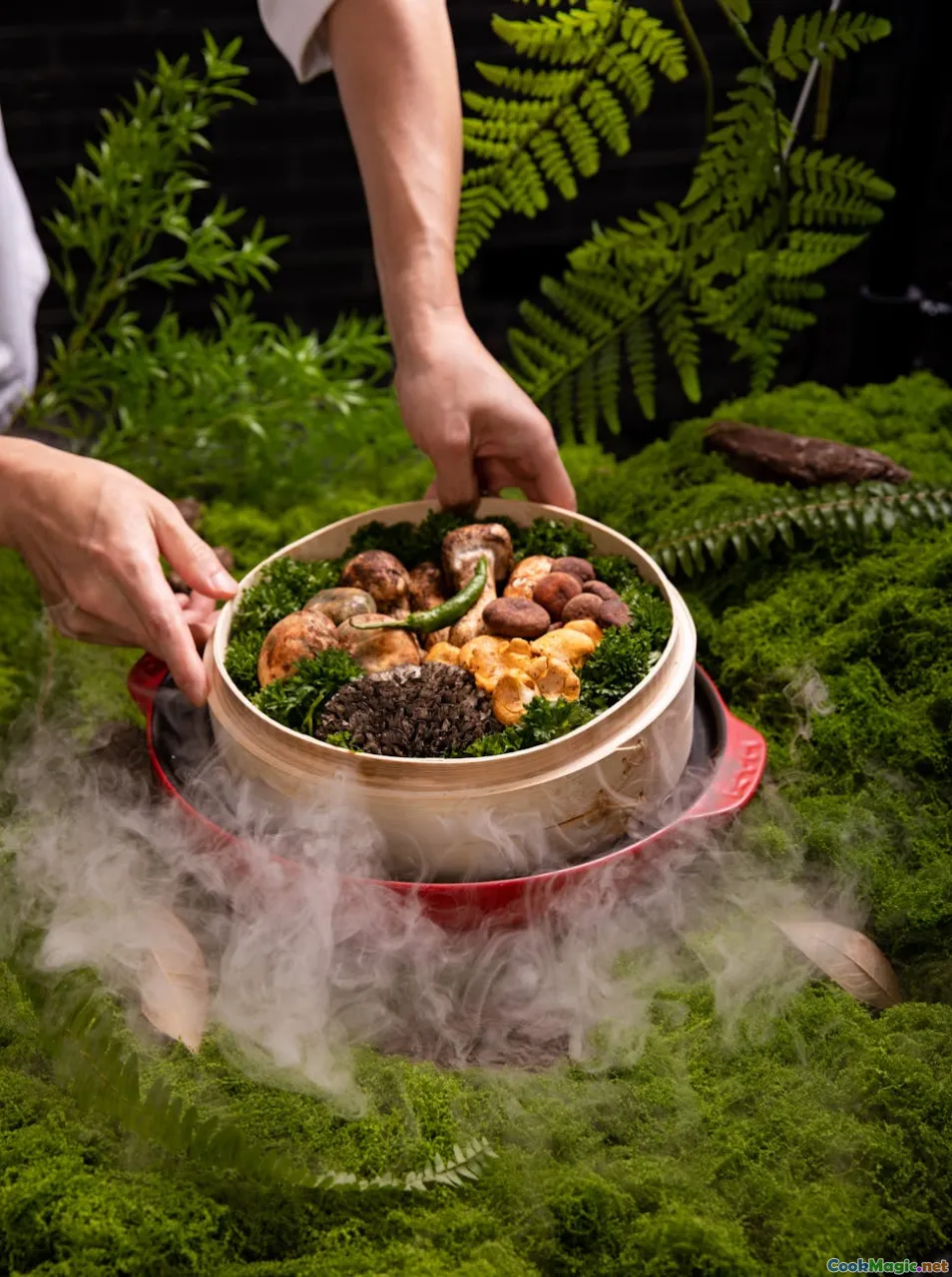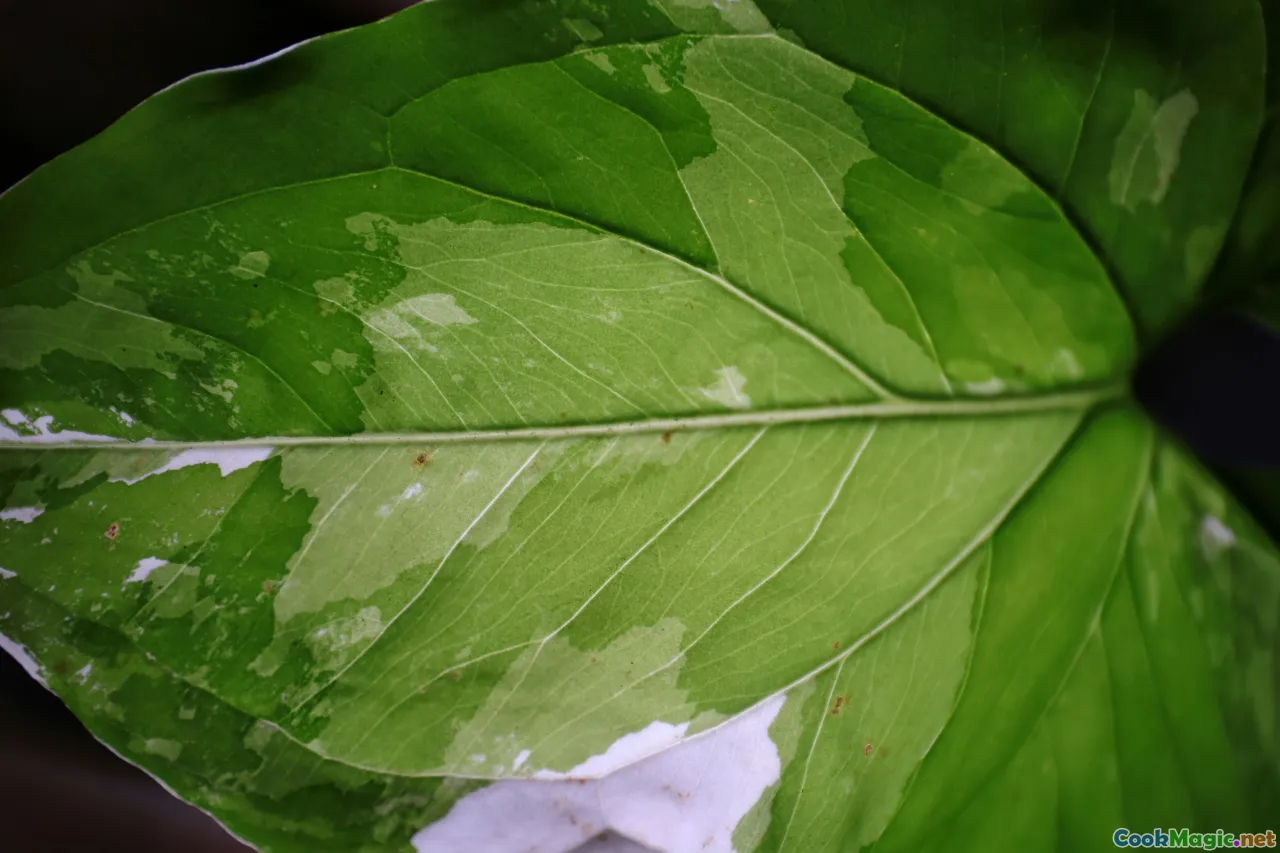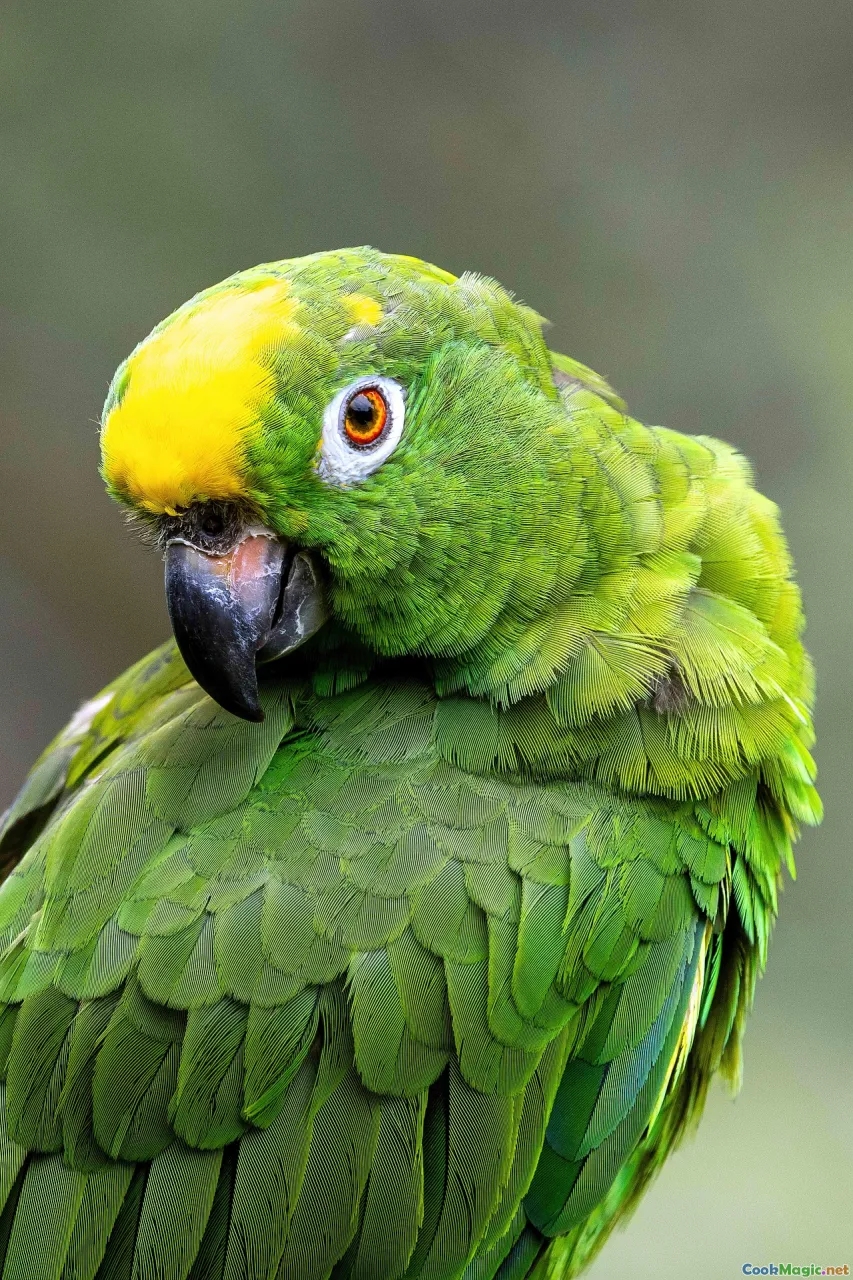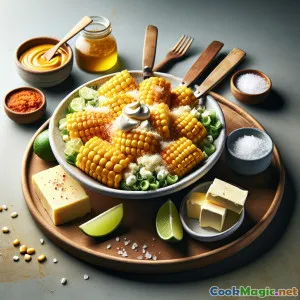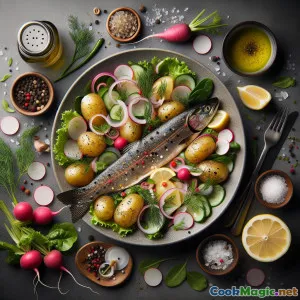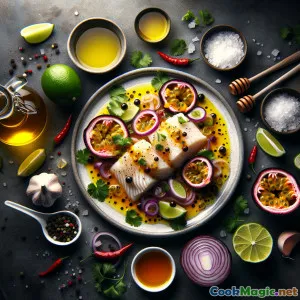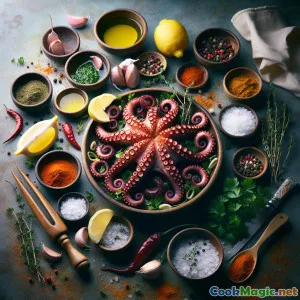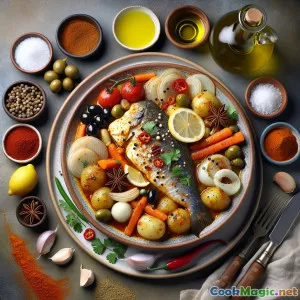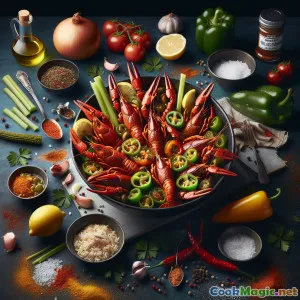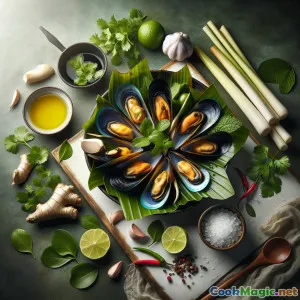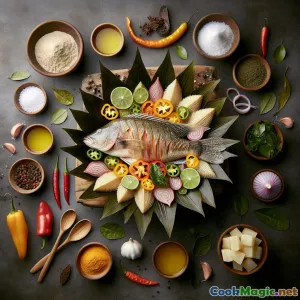
Maito Amazonien : Tilapia Vapeur dans des Feuilles de Bijoa
(Amazonian Maito: Tilapia Steamed in Bijao Leaves)
(0 Avis)0
410
juillet 23, 2025
Signaler un problème
Ingrédients
-
2 pieces (about 250g each) Filets de tilapia
(Choose fresh and firm fillets for best flavor.)
-
2 leaves Feuilles de bijao (appelées 'bijao' ou 'Calathea lutea')
(If unavailable, substitute with banana leaves.)
-
1 tbsp Huile d'achiote (annatto)
(For color and subtle earthy flavor.)
-
10 grams Feuilles de coriandre sauvage (Eryngium foetidum)
(Or replace with fresh cilantro for similar effect.)
-
2 cloves Gousses d'ail
(Finely chopped or crushed.)
-
1 medium (about 70g) Poivrons rouges sucrés
(Deseeded and thinly sliced.)
-
1 small (20g) Piment jaune (ají amarillo)
(Deseeded and finely chopped. Omit seeds for less heat.)
-
1 tsp Graines de culantro sacha (optionnel, pour un arôme authentique)
(May omit if unavailable.)
-
1 tsp Sel
(Season generously.)
-
0.5 tsp Poivre noir
(Fraîchement moulu)
-
2 tbsp Jus de citron vert
(Adds brightness.)
-
250 grams Manioc (tapioca), pelé et coupé
(Traditional Amazonian side, optional.)
(Choose fresh and firm fillets for best flavor.)
(If unavailable, substitute with banana leaves.)
(For color and subtle earthy flavor.)
(Or replace with fresh cilantro for similar effect.)
(Finely chopped or crushed.)
(Deseeded and thinly sliced.)
(Deseeded and finely chopped. Omit seeds for less heat.)
(May omit if unavailable.)
(Season generously.)
(Fraîchement moulu)
(Adds brightness.)
(Traditional Amazonian side, optional.)
Nutrition
- Portions: 2
- Taille de portion: 1 parcel (250g)
- Calories: 350 kcal
- Carbohydrates: 20 g
- Protein: 38 g
- Fat: 14 g
- Fiber: 3 g
- Sugar: 2 g
- Sodium: 850 mg
- Cholesterol: 80 mg
- Calcium: 70 mg
- Iron: 2.2 mg
Instructions
-
1 - Prepare Bijao Leaves:
Gently wash bijao leaves. Quickly toast them over open flame or dry skillet (about 10 seconds each side) to soften and release aroma. Trim any tough stems.
-
2 - Herb Preparation:
Finely chop culantro, garlic, sweet red pepper, and, if using, ají amarillo and sacha culantro seeds. Mix in a bowl with annatto oil, salt, black pepper, and lime juice.
-
3 - Marinate Tilapia:
Pat tilapia fillets dry with paper towels. Rub prepared herb-oil mixture evenly on each side. Rest for 10 minutes for flavor absorption.
-
4 - Wrap Fish in Bijao Leaves:
Place each marinated tilapia fillet at the center of a bijao leaf. Fold edges of leaf over fish to create a tight, secure parcel. Tie with kitchen twine if needed.
-
5 - Steam or Grill Parcels:
Place parcels on a bamboo steamer or directly on hot grill over medium-low flame. Steam or grill 25-30 minutes, flipping halfway through if grilling, until fish is opaque and flakes.
-
6 - Prepare Optional Cassava:
If serving, boil cassava chunks in salted water until tender (about 20 minutes). Drain and keep warm.
-
7 - Serve:
Carefully open bijao parcels and serve one per person. Garnish with reserved herb leaves. Serve with cassava, accompanied by lime wedges if desired.
Gently wash bijao leaves. Quickly toast them over open flame or dry skillet (about 10 seconds each side) to soften and release aroma. Trim any tough stems.
Finely chop culantro, garlic, sweet red pepper, and, if using, ají amarillo and sacha culantro seeds. Mix in a bowl with annatto oil, salt, black pepper, and lime juice.
Pat tilapia fillets dry with paper towels. Rub prepared herb-oil mixture evenly on each side. Rest for 10 minutes for flavor absorption.
Place each marinated tilapia fillet at the center of a bijao leaf. Fold edges of leaf over fish to create a tight, secure parcel. Tie with kitchen twine if needed.
Place parcels on a bamboo steamer or directly on hot grill over medium-low flame. Steam or grill 25-30 minutes, flipping halfway through if grilling, until fish is opaque and flakes.
If serving, boil cassava chunks in salted water until tender (about 20 minutes). Drain and keep warm.
Carefully open bijao parcels and serve one per person. Garnish with reserved herb leaves. Serve with cassava, accompanied by lime wedges if desired.
En savoir plus sur: Maito Amazonien : Tilapia Vapeur dans des Feuilles de Bijoa
Maito de Tilapia Amazónico en Hoja de Bijao
If there's a dish that truly captures the spirit of the Peruvian Amazon, it's the Maito de Tilapia en Hoja de Bijao. This vibrant preparation is more than a recipe—it's a culinary homage to the rainforest, where cooking with what the land offers isn't just tradition, it's a way of life. In this rendition, we're using tilapia—a fish cultivated throughout the Amazonian basins—and pairing it with the bijao leaf (Calathea lutea), a wide, aromatic green used across the jungle to infuse food with aroma and character.
Origins & Cultural Significance
'Maito' is a Quechua word that means “bundle” or “parcel.” The technique of wrapping fish or meat in bijao leaves and then either steaming or grilling over smoldering coals traces back centuries in Amazonian indigenous communities. This approach evolved not only for reasons of flavor but also as a guarantee that the food would be tender, juicy, and easy to carry through the forest—plus the natural oils in the leaf help preserve food. Bijao leaves are the Amazonian answer to parchment paper, providing a fragrant, slightly sweet outer layer that both protects and perfumes the fish.
In villages scattered along the Ucayali or Nanay rivers, you'll find the smoky-sweet scent of maito parcels punctuating early evenings as families gather to eat. Traditionally, secuestrum (another native fish), paiche, or dorado might be used, but tilapia has become increasingly relied upon for its firm texture and light flavor—allowing the Amazon herbs and bijao smokiness to shine through.
Unique Aspects
What's distinctive about the maito is the almost meditative wrapping process. It personifies respect for nature—the leaves efficiently replacing single-use materials and imparting an unmistakable green, woodsy perfume. The addition of culantro (cousin to cilantro), achiote for color, and crunch from sweet pepper brings layers to every tender bite. Avatars of Amazonian flavor—like sacha culantro seeds or ají amarillo—transport this dish deeply into the rainforest pantry.
You'll also find meals started by offering small bites to Pachamama (Mother Earth) as a sign of gratitude, exemplifying ritual and reverence that's imbued into every Amazonian feast.
Steps, Tips, & Variations
- Cooking Method: If you can't find bijao, banana or even sturdy corn husks will suffice, though some aroma will be absent. Adapt grill or oven methods as your kitchen allows—just ensure the parcels seal tightly, as that's key for steaming.
- Heat Level: Amazon cuisine flirts with chili heat, so feel free to add or omit ají amarillo based on tolerance. Sacha culantro seeds are aromatic; they're tricky to find outside South America but aren't essential.
- Accompaniment: Cassava, or yuca, boiled until just tender and served hot, is classic. It's not only filling but captures the rustic simplicity locals adore. Plantains on the side are popular too.
- Serving: Tear open the hot bijao at the table for a rustic jungle experience—the first inhale is half the pleasure.
Health & Nutrition
This is a dish at the crossroads of nutrition and tradition. Calmly steamed, there's little fat and a protein hit from fish, plus all the vitamins from herbs and the root vegetable if you choose. It's inherently gluten-free and adaptable to many dietary requirements.
Personal Thoughts & Final Tips
Recreating maito at home is more than a recapitulation of a recipe: it’s a window into an eco-conscious cuisine. The interplay of fresh fish, perfumed leaves, root vegetables, and herbs embodies Amazonian biodiversity. It’s simultaneously earthy, contemporary (in its focus on local, sustainable ingredients), and warmly communal. Consider serving it outdoors, just as it is shared along the riverbanks, for a meal that engages every sense—colorful, gently spiced, smoky, and above all, deeply nourishing.
Do try this dish. Savor the contrasts and let it transport you, just for an evening, to that leafy, river-rich heart of the Amazon.

